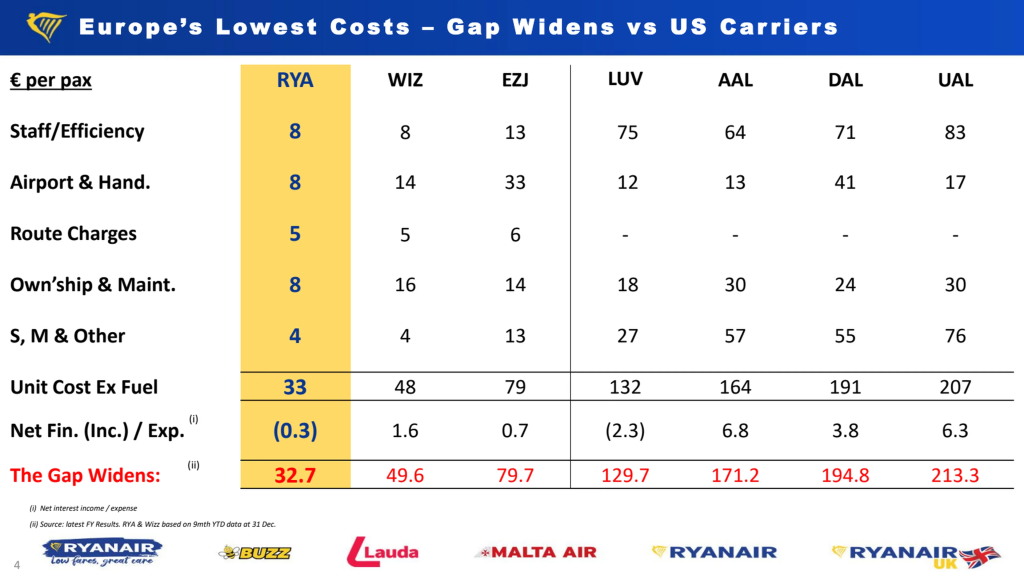Ryanair Profit Growth Soars 42% as CEO Criticizes Reeves’ Economic Policy
On 3 November 2025, the budget carrier Ryanair surprised the market by posting a 42% profit growth in its half-year net profit, reaching €2.54 billion for the six months to the end of September.
At the same time, its long-time chief executive, Michael O’Leary, didn’t hold back. He publicly slammed UK Chancellor Rachel Reeves and questioned the direction of the UK’s economic policy.
Why does this matter? Ryanair’s strong performance demonstrates how rapid airline recovery, effective cost control, and fleet renewal are redefining success in the post-pandemic travel landscape. And O’Leary’s critique points to a deeper debate: are government tax and regulation strategies helping businesses grow or holding them back?
Let’s find out how Ryanair soared, what’s behind the leap, and why the CEO’s remarks could echo across the industry.
Ryanair’s Financial Performance Overview

Ryanair reported a six-month net profit of €2.54 billion for the period ending 30 September 2025. This figure marked a 42% increase from the prior year. Passenger numbers rose to 119 million in the half, up 3% year-on-year. Revenues for the six months reached about €9.82 billion. The carrier also nudged up its full-year traffic forecast to 207 million passengers after earlier-than-expected Boeing deliveries. These results were disclosed on 3 November 2025.
Key Drivers Behind the 42% Profit Surge
Fare recovery led the gains. Average fares rose around 13%, lifting revenue per passenger. Strong holiday demand in spring and summer added to the lift. Ryanair also benefited from faster Boeing 737 MAX deliveries. The airline received 23 extra MAX-8s earlier than planned. This freed capacity and cut unit costs.

Ancillary income grew modestly but steadily. Fuel hedging helped too. Ryanair locked part of its fuel needs at lower prices for fiscal 2027. All these factors combined to push margins higher in H1.
CEO Michael O’Leary’s Critique of Rachel Reeves’ Economic Policy
Michael O’Leary used the results day platforms to attack UK economic policy. He said the UK economy risked stagnation under the current approach and singled out Chancellor Rachel Reeves. O’Leary warned that planned rises in Air Passenger Duty (APD) and wealth taxes could harm growth and push some traffic away from smaller UK airports.
He argued that higher taxes would lower competitiveness and deter wealthy travellers and businesses. His comments came amid wider debate over taxation ahead of a UK Budget later in November 2025. The remarks sparked sharp comment in UK media and a short response from Treasury spokespeople.
Market and Investor Reactions
Shares showed mixed moves after the announcement. Some markets pared gains as investors weighed near-term fare pressure and external risks. Analysts raised profit estimates slightly in light of the strong H1. Several broker notes pointed to upside from the earlier Boeing deliveries.
A few warned that softer winter demand could blunt momentum. Some market teams used advanced models to run scenario analysis, including one that referenced AI to test downside risks from higher taxes or rising fuel costs. Overall sentiment leaned positive but cautious.
Broader Industry Context
The Ryanair Profit Growth reflects a wider European trend. Airlines that cut capacity during the pandemic and then restored it selectively have seen fare power. Fuel prices remain volatile but are lower than last year for many carriers. Labour disputes and airport capacity constraints still pose risks.

Regulators are also tightening rules on baggage and environmental charges in parts of Europe. These rules could raise costs or alter ancillary revenue mixes. Yet Ryanair’s low-cost model and scale give it a relative edge. Competitors like easyJet and Wizz Air reported healthier results, but none matched Ryanair’s H1 profit jump in absolute euro terms.
Strategic Moves and Competitive Advantages
Fleet renewal is central to Ryanair’s plan. The airline has placed large orders for MAX-10s, with deliveries set to start in 2027. New planes yield fuel savings and lower maintenance bills. Ryanair also focuses on high load factors and quick aircraft turns. Pricing discipline remains key.
The group keeps pushing ancillary offerings like priority boarding and seat sales. Expansion in markets with weak competition has boosted yields. Finally, its strong cash flow supports growth even if headwinds hit.
Ryanair Profit Growth: Risks and Headwinds
Several risks could trim forecasts. A UK decision to raise APD or widen wealth taxes could reduce demand or shift routes. Fuel spikes would hit costs despite hedges. Slowing economic growth across Europe could lower discretionary travel. Airport strikes and capacity limits at major hubs would squeeze schedules.
Environmental regulation could force added charges or operational costs. Any delay in Boeing deliveries or regulatory setbacks for new pilots would also constrain expansion. Analysts warn that these threats could turn a strong H1 into a softer full year if they materialize.
Future Outlook and Strategic Priorities
Ryanair upgraded its passenger target to 207 million for the full fiscal year after the H1 beat and early plane arrivals. Management plans to recruit pilots faster. The group will press for lower aviation taxes in markets where it operates. It will also continue hedging fuel and keeping a tight cost base.
Investment in digital tools and route optimization is expected to squeeze further efficiency from the fleet. Ryanair’s stated aim is to protect fares while growing market share. How government tax plans unfold will influence that path.
Wrap Up
The H1 results to 30 September 2025 show Ryanair firing on several cylinders. Higher fares. More seats from early Boeing deliveries. Tight cost control. Those forces combined to lift profit by 42% and push passenger guidance up.
Michael O’Leary’s public criticism of Rachel Reeves adds a political layer. The debate over taxes and regulation could shape demand and route strategy in 2026. For now, Ryanair sits in a strong spot. But future gains may hinge on policy choices, fuel moves, and how quickly rivals react.
Frequently Asked Questions (FAQs)
On 3 November 2025, Ryanair said profits rose 42% because more people flew during the summer, ticket prices increased, and new planes helped cut fuel costs.
On 3 November 2025, CEO Michael O’Leary said UK Chancellor Rachel Reeves’ tax ideas could slow business growth and make air travel more expensive for British passengers.
Ryanair plans to add more routes, buy new Boeing jets, and use digital tools to lower costs and grow passenger numbers through 2026.
Disclaimer: The content shared by Meyka AI PTY LTD is solely for research and informational purposes. Meyka is not a financial advisory service, and the information provided should not be considered investment or trading advice.






